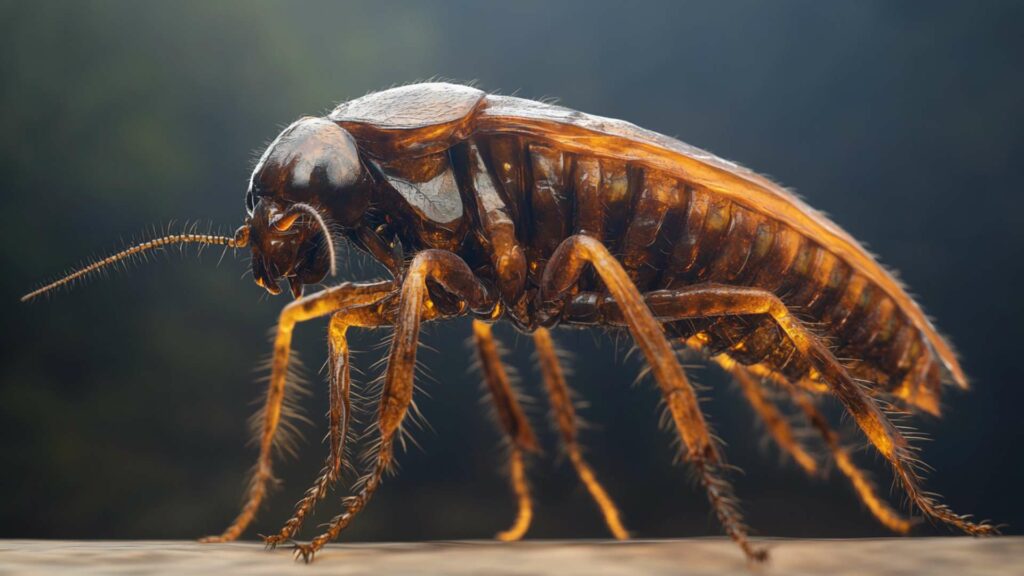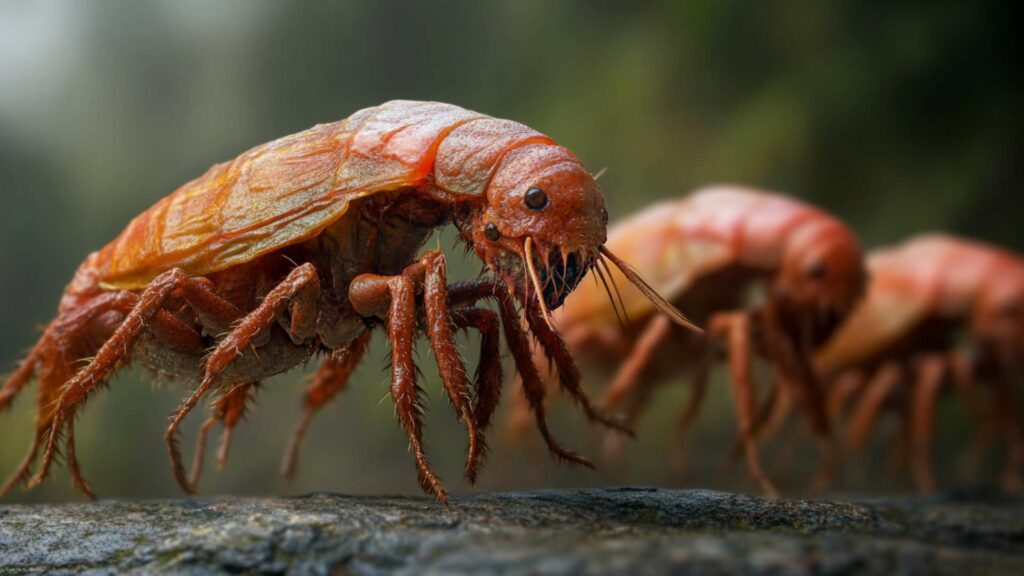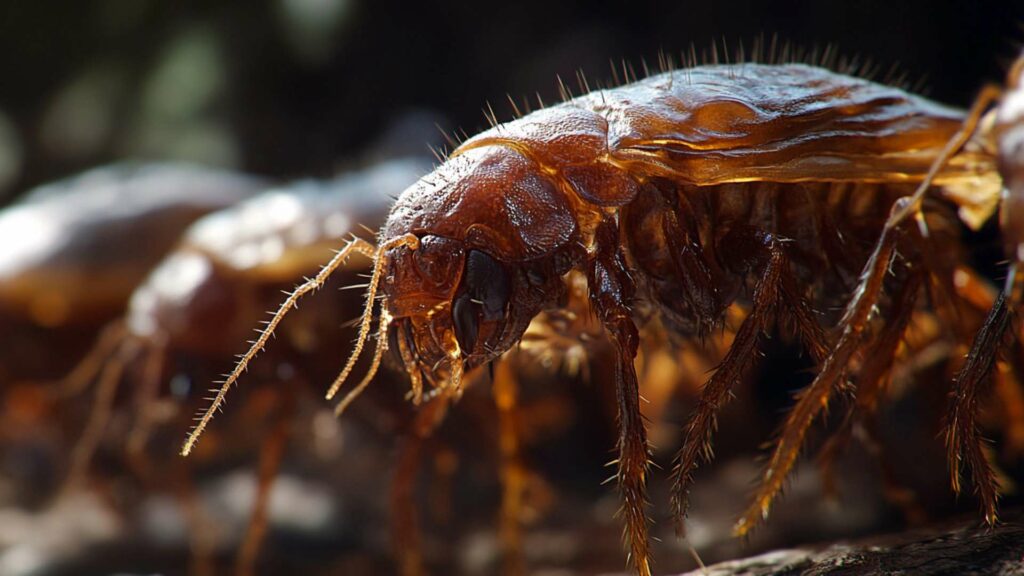Fleas, those pesky little creatures that drive pet owners to the brink of frustration, are small but mighty insects that belong to the order Siphonaptera. These minuscule bloodsuckers thrive on the blood of mammals and birds, with the most common varieties infesting our beloved dogs and cats.
The female flea is a prolific reproducer and can lay hundreds of eggs in her lifetime. Understanding the flea feces and their life cycle is crucial in combating these relentless pests.
The life cycle of a flea consists of four stages: egg, larva, pupa, and adult flea. It all begins when a female flea finds herself on a host animal—usually our furry companions—and starts feeding on their blood.
Once satiated, she will lay her minuscule eggs within hours directly onto the host’s skin or more commonly into their fur. With their smooth surface texture and minute size (about 0.5mm), these eggs often go unnoticed unless inspected closely with a magnifying glass.
The Importance of Understanding Where Fleas Lay Their Eggs
Comprehending where fleas lay their eggs is paramount for effectively controlling these bothersome critters. Killing adult fleas alone won’t solve the problem entirely since each adult flea represents only a small portion of the overall population kill fleas at any given time.
By targeting where fleas lay eggs, we can interrupt their life cycle and prevent full-blown infestations from taking hold in our homes. Flea eggs are not sticky like those of many other insects; therefore, they don’t stick to your pet’s skin but instead fall off wherever your furry friend roams—indoors or outdoors!
This fact underscores why it’s essential to be aware of potential breeding grounds both inside your home and in your pet’s immediate environment like their bedding or resting areas. By identifying these hotspots, we can implement targeted strategies to halt the reproduction of fleas and protect our pets from incessant itching and flea bites.
Understanding the favored egg-laying spots for fleas is equally crucial for maintaining a clean and hygienic living space. Flea eggs thrive in warm environments with high relative humidity, making carpets, rugs, and upholstery prime real estate for these tiny invaders.
Furthermore, shaded outdoor areas with organic debris can also serve as occasional egg-laying sites. By staying informed about these preferred habitats, we can adopt proactive measures such as regular vacuuming or maintaining cleanliness in outdoor spaces to prevent their infestation.
In the forthcoming sections of this article, we will explore the specific locations where fleas lay their eggs in greater detail: from your pet’s fur to your cozy carpets and even some unexpected places you as pet parents might not have considered. Armed with this knowledge, you’ll be better equipped to tackle fleas head-on and protect both your furry friends and your home from these persistent pests.
Flea Life Cycle
Explanation of the Four Stages: Egg, Larva, Pupa, Adult Flea
To understand where fleas lay their eggs, it is essential to familiarize ourselves with their life cycle. The flea life cycle consists of four distinct life stages namely: egg, larva, pupa, and adult flea.
Each stage plays a critical role in the survival and reproduction of these pesky creatures. Let’s start at the beginning with flea eggs.
Female fleas are responsible for laying eggs on their primary food source: our beloved pets. They can lay up to 50 eggs every day!
These minuscule white ovals are about 0.5mm in size and often go unnoticed within our pet’s fur or their surroundings. Once laid, these tiny flea eggs hatch into flea larvae hatch out within one to twelve days.
The larvae are blind and avoid light by hiding deep within carpets, pet bedding, or other cozy nooks and crannies where they can feed on organic debris and develop into the next stage. After weeks of feeding and molting several times as larvae, they enter the pupal stage—a protective cocoon-like structure that shields them from external disturbances like flea control products or environmental factors.
Inside this delicate casing, they metamorphose into adult fleas over a span of days to weeks. Emerging from their snug cocoons as fully developed adults ready to feast on your furry friends’ blood—this is when you may notice the irritating itch caused by these relentless little creatures crawling through your dog’s coat or cat fleas infesting your pet’s skin.
Emphasis on the Significance of Targeting Eggs to Control Flea Infestations
Now that we have learned about the different stages of a flea’s life cycle let’s understand why targeting flea eggs is crucial in combating a flea problem effectively. Flea eggs are the foundation of infestations, as they make up about 50% of rid of flea eggs of the total population in an infested area.
They are a silent nuisance, as they often go unnoticed due to their small size and light coloration. However, they play a significant role in perpetuating flea populations.
By focusing on eliminating flea eggs, you can interrupt the life cycle and prevent future generations of fleas from emerging. This approach to killing flea eggs is essential because while adult fleas can be killed using various flea control products available in the market, if you fail to address the underlying egg population, new fleas will continue to hatch and cause trouble.
By killing flea eggs and breaking this cycle at its source, not only will you get rid of fleas already present on your pets or in your home but also ensure long-term control and prevention. Remember that killing adult fleas is just one part of a holistic approach to combating fleas; targeting their eggs is equally vital for effective pest control.
So now that we understand the significance of targeting flea eggs let’s delve deeper into where exactly these little nuisances prefer to lay their viable eggs and how we can tackle them head-on.
Preferred Egg-Laying Spots for Fleas
Pets as Primary Hosts and Egg-Laying Sites

Fleas, those pesky blood-sucking critters, have a particular affinity for our furry friends. Dogs and cats often serve as the primary hosts and egg-laying sites due to their warm coats and abundant hiding spots.
Fleas are cunning little creatures that possess an uncanny ability to remain hidden in your pet’s fur, making it challenging to detect their eggs. These tiny oval-shaped eggs tend to cling near the base of your pet’s hairs or find their way down to the skin surface.
Fur and Skin Areas Where Fleas Prefer to Lay Eggs on Pets
When it comes to choosing prime egg-laying spots on your beloved companions, fleas have their preferences. In dogs, these persistent parasites commonly target areas with dense fur such as the back of the neck, behind the ears, along the tail base, and in the armpits. Cats are not exempt from this torment either; they often experience flea infestations around their necks, between shoulder blades, on their bellies, or thighs.
Importance of Regular Grooming to Detect and Remove Flea Eggs

To keep your pets safe from a full-blown flea infestation, regular grooming is key. Grooming not only helps maintain cleanliness but also serves as an opportune moment for early detection of flea eggs or even adult fleas themselves. By carefully combing through your pet’s coat with a fine-toothed comb known as a flea comb, you can catch those elusive flea eggs that look like this before they hatch into an army of hungry fleas.
Indoor Environments as Secondary Egg-Laying Sites
While our pets remain favored targets for flea egg deposition, these pests do not limit themselves to just our furry friends. Fleas are crafty invaders that have learned to exploit our indoor environments as secondary egg-laying sites. Carpets, rugs, and upholstery serve as ideal breeding grounds where fleas find warmth and protection for their eggs.
Explanation of Why These Areas Provide Warmth and Protection for Eggs
Our carpets, rugs, and upholstery provide the perfect combination of shelter and insulation to support the survival and development of flea eggs. The fibers of these materials create a cozy microenvironment where temperatures remain relatively stable, allowing the flea eggs to accumulate and to incubate undisturbed. Moreover, these areas attract accumulated pet dander or organic debris that can act as a food source for flea larvae once they hatch.
Tips for Vacuuming Regularly to Eliminate Flea Eggs from Indoor Spaces

To thwart the insidious plans of fleas lurking within your home, regular vacuuming is essential. By vacuuming your floors, carpets, rugs, and upholstery on a frequent basis—preferably at least once a week—you can significantly reduce the number of flea eggs present in your indoor spaces.
Make sure to focus on areas where pets spend most of their time resting or playing. Additionally, you may consider using pet-safe dish soap in warm water as part of your cleaning routine since it can help kill adult fleas and flea eggs upon contact.
Outdoor Environments as Occasional Egg-Laying Sites
While fleas primarily rely on pets and indoor spaces for egg-laying purposes, they occasionally venture into outdoor environments too. Shaded areas with organic debris often become favored outdoor locations where fleas may deposit their eggs.
Description of Common Outdoor Locations Favored by Fleas
In your yards or gardens, fleas typically gravitate towards shady spots such as under trees or in dense shrubbery. These areas provide the necessary protection against direct sunlight and extreme temperatures, ensuring the survival of the eggs. Fleas may also choose to lay their eggs in outdoor pet bedding or any secluded area where wildlife or stray animals seek shelter.
Suggestions for Maintaining Cleanliness in Outdoor Spaces to Prevent Infestations
To prevent outdoor flea infestations, maintaining cleanliness is paramount. Regularly clearing away organic debris, such as fallen leaves or grass clippings, can significantly reduce potential egg-laying sites for fleas.
Moreover, make sure to keep your lawn well-groomed and trim any dense vegetation that may provide hiding places for these persistent parasites. Implementing pest control strategies specifically designed for outdoor spaces, such as natural repellents or nematodes that target flea larvae, can also aid in preventing infestations.
Remember, understanding where fleas lay their eggs empowers you to take proactive measures against these tiny terrors. By being vigilant with your pets’ grooming routine and keeping both indoor and outdoor environments clean, you can greatly minimize the chances of a flea infestation taking hold within your home and surroundings.
Uncommon Egg-Laying Spots for Fleas (Interesting Facts)
Unusual places where fleas may lay their eggs
Fleas are notorious for their adaptability and resourcefulness when it comes to finding suitable spots to lay their eggs. While the majority of flea eggs are found on pets or in indoor environments, there are some rather unexpected locations where these tiny pests decide to establish their nurseries.
One such surprising spot is nestled within nests or bedding materials used by wildlife or stray animals. These cozy sanctuaries provide warmth, protection, and an ample supply of potential hosts for fleas seeking a blood meal.
Nests or bedding materials used by wildlife or stray animals
Fleas have evolved to take advantage of the living spaces created by wildlife and stray animals as prime egg-laying spots. Whether it’s burrows dug by small mammals like rabbits, natural hollows in trees frequently visited by squirrels, or abandoned bird nests hidden among foliage, fleas find comfort in these environments.
The soft fibers and organic matter found within such nests or bedding materials offer a perfect breeding ground for flea eggs. When wildlife or stray animals vacate these areas, flea populations can explode if left unchecked.
Cracks or crevices in floors or walls
It may surprise you to learn that fleas can utilize even the tiniest cracks and crevices within your home as egg-laying spots. These elusive insects possess a remarkable ability to squeeze through minuscule openings and quickly burrow deep into your living space.
Once inside, they search for hidden nooks and crannies like narrow gaps between floorboards, loose wallpaper edges, or small openings around windowsills. These often overlooked areas provide shelter from light and disturbances while offering an ideal site for protecting their precious cargo of flea eggs.
Human clothing or furniture if infested
While fleas primarily target animals as hosts, under extreme circumstances, they can infest humans as well. If an individual finds themselves in close proximity to a full-blown flea infestation, these persistent pests can take refuge in human clothing or furniture.
Flea eggs may fall off an infested pet’s fur and onto sofas, beds, or carpets within the home. Once there, the eggs can hatch into tiny worms known as flea larvae who quickly seek shelter within the fibers of fabric or crevices of furniture.
This scenario highlights the importance of swift action to get rid of fleas from homes and prevent further infestation. Fleas are skilled at finding unconventional places to lay their eggs.
From animal nests and bedding materials to cracks in floors or walls, and even human clothing or furniture in severe cases confuse flea eggs everywhere. Understanding these lesser-known egg-laying spots is crucial for effective flea control and prevention.
By regularly inspecting and maintaining cleanliness in both indoor and outdoor environments susceptible to flea infestation, you can significantly reduce the risk of allowing these pesky insects to establish themselves in your living spaces.
Egg-Laying Habits and Considerations
Flea Reproductive Habits and Prolific Nature
Fleas are notorious for their incredible reproductive abilities. Female fleas have the remarkable capacity to lay hundreds of eggs throughout their lifespan, which can vary from a few weeks to several months. These tiny insects are highly motivated to reproduce, as their survival depends on it.
Once a female flea finds a suitable host, it begins feeding on its blood within minutes. With an abundant supply of nutrients from its host, the female flea can produce an impressive number of viable eggs.
The reproductive process is fascinating yet concerning. After consuming enough blood, the female flea starts laying eggs within 36-48 hours.
These eggs do not remain attached to the host’s fur or skin but instead, fall off into the environment as the pet moves around or rests. Thus, understanding where fleas lay their eggs becomes crucial in combating infestations effectively.
Conclusion
Comprehending the egg-laying habits of fleas is vital in tackling and preventing flea infestations successfully. Fleas reproduce rapidly and abundantly due to their exceptional fertility rates and resourcefulness in finding suitable hosts. By knowing where these tiny pests prefer to lay their eggs — such as in your pet’s bedding or in cozy indoor environments like carpets – you can take proactive measures to control them.
Remember that eliminating fleas requires a multi-step approach that includes treating both your pets and their living spaces with appropriate flea products like flea shampoo or insect growth regulators. Regular grooming with a flea comb can help detect and remove fleas or viable eggs from your pet’s coat while vacuuming carpets frequently is essential for eradicating any potential hiding spots for these pesky creatures.
By staying vigilant about maintaining cleanliness indoors and outdoors, you can significantly reduce the chances of encountering a widespread flea problem. So, take charge of the flea poop situation and bid farewell to those bothersome flea bites!
Get rid of fleas with D-Termination: Las Vegas’ leading pest control service!

If you’re dealing with flea issues on your Las Vegas property, D-Termination is here to assist. Our expert team specializes in eliminating flea infestations and restoring comfort and peace to your space. Say farewell to fleas—opt for D-Termination for effective pest control today!
Contact us at 702-919-6310 or visit dtermination.com to schedule your flea control service and reclaim your space from these troublesome pests.
Frequently Asked Questions:
Fleas often lay eggs in areas frequented by pets, such as bedding, carpets, and furniture.
Fleas can nest in various places within homes, with carpets, pet bedding, and cracks in floors being common.
Yes, fleas can lay eggs in human beds, especially if pets share the sleeping area.
Common places for fleas to lay eggs include carpets, pet bedding, and areas where pets spend a lot of time.







